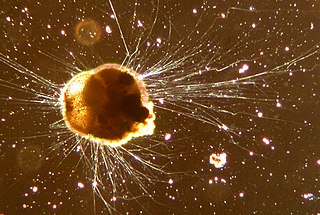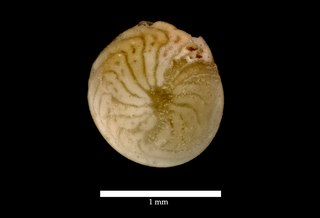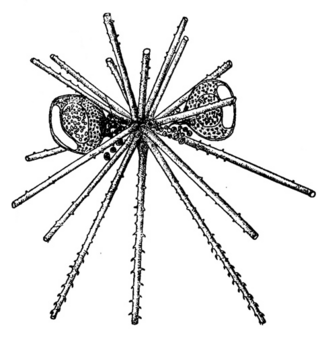
The Paleogene Period is a geologic period and system that spans 43 million years from the end of the Cretaceous Period 66 million years ago (Mya) to the beginning of the Neogene Period 23.03 Mya. It is the first part of the Cenozoic Era of the present Phanerozoic Eon. The earlier term Tertiary Period was used to define the span of time now covered by the Paleogene Period and subsequent Neogene Period; despite no longer being recognized as a formal stratigraphic term, "Tertiary" still sometimes remains in informal use. Paleogene is often abbreviated "Pg", although the United States Geological Survey uses the abbreviation "Pe" for the Paleogene on the Survey's geologic maps.

Plankton are the diverse collection of organisms found in water that are unable to propel themselves against a current. The individual organisms constituting plankton are called plankters. In the ocean, they provide a crucial source of food to many small and large aquatic organisms, such as bivalves, fish, and baleen whales.

The Radiolaria, also called Radiozoa, are protozoa of diameter 0.1–0.2 mm that produce intricate mineral skeletons, typically with a central capsule dividing the cell into the inner and outer portions of endoplasm and ectoplasm. The elaborate mineral skeleton is usually made of silica. They are found as zooplankton throughout the global ocean. As zooplankton, radiolarians are primarily heterotrophic, but many have photosynthetic endosymbionts and are, therefore, considered mixotrophs. The skeletal remains of some types of radiolarians make up a large part of the cover of the ocean floor as siliceous ooze. Due to their rapid change as species and intricate skeletons, radiolarians represent an important diagnostic fossil found from the Cambrian onwards.

Foraminifera are single-celled organisms, members of a phylum or class of Rhizarian protists characterized by streaming granular ectoplasm for catching food and other uses; and commonly an external shell of diverse forms and materials. Tests of chitin are believed to be the most primitive type. Most foraminifera are marine, the majority of which live on or within the seafloor sediment, while a smaller number float in the water column at various depths, which belong to the suborder Globigerinina. Fewer are known from freshwater or brackish conditions, and some very few (nonaquatic) soil species have been identified through molecular analysis of small subunit ribosomal DNA.

Holoplankton are organisms that are planktic for their entire life cycle. Holoplankton can be contrasted with meroplankton, which are planktic organisms that spend part of their life cycle in the benthic zone. Examples of holoplankton include some diatoms, radiolarians, some dinoflagellates, foraminifera, amphipods, krill, copepods, and salps, as well as some gastropod mollusk species. Holoplankton dwell in the pelagic zone as opposed to the benthic zone. Holoplankton include both phytoplankton and zooplankton and vary in size. The most common plankton are protists.

Globigerina is a genus of planktonic Foraminifera, in the order of Rotaliida. It has populated the world's oceans since the Middle Jurassic.
The Danian is the oldest age or lowest stage of the Paleocene Epoch or Series, of the Paleogene Period or System, and of the Cenozoic Era or Erathem. The beginning of the Danian is at the Cretaceous–Paleogene extinction event 66 Ma. The age ended 61.6 Ma, being followed by the Selandian.
Abathomphalus is a genus of foraminifera included in the Globotruncanid family.
Miliamellus is a genus of Cenozoic benthic foraminifera with tests made of imperforate opaline silica. It is the only genus in the order Silicoloculinida and the family Silicoloculinidae. It is sometimes referred to by the junior synonym Silicoloculina.

Cibicides is a genus of cosmopolitan benthic foraminifera known from at least as far back as the Paleocene that extends down to the present.
Hedbergella is an extinct genus of planktonic foraminifera from the Cretaceous, described by Loeblich and Tappan, 1961, as:
Test free, trochospiral, biconvex, umbilicate, periphery rounded with no indication of keel or poreless margin; chambers globular to ovate; sutures depressed, radial, straight or curved; wall calcareous, finely perforate, radial in structure, surface smooth to hispid or rugose; aperture an interiomarginal, extraumbilical-umbilical arch commonly bordered above by a narrow lip or spatulate flap, ... Includes species otherwise similar to Praeglobotruncana but which lack a keel or poreless margin, hence is regarded as a separate genus rather than as a subgenus of Praeglobotruncana as by Banner and Blow (1959).
Kalosha is a genus of foraminifera included in the miliolid family Spiroloculinidae. Its test is small, ovate in outline, only up to 0.2 mm in the greatest dimension; begins with an oval proloculus followed by planispirally coiled elongate tubular chambers one-half coil in length, forming three to five whorls. The wall is calcareous, hyaline (glassy), and imperforate. The aperture is a narrow slit at the end of the final chamber.
Globigerinoides is an extant genus of shallow-water planktonic foraminifera of family Globigerinidae. First appearing in the Oligocene these foraminifera are found in all modern oceans. Species of this genus occupy the euphotic zone, generally at depths between 10-50m, in waters which cover a range of salinities and temperatures. They are a shorter lived species, especially when compared to Globorotalia genus. As a genus Globigerinoides is widely used in various fields of research including biostratigraphy, isotope geochemistry, biogeochemistry, climatology, and oceanography.

Amphistegina is a genus of foraminiferal protists included in the Rotaliida with a stratigraphic range extending from the Eocene to recent and a cosmopolitan distribution. The test is an asymmetrically biconvex trochospiral that may be bi-involute or partially evolute on the spiral side. Chambers are numerous, broad. and low, strongly curved back at the periphery to form chamber prolongations. The umbilical side is stellate, like that of Asterigerina, and has a distinct umbilical plug. The wall is calcareous, optically radial; the surface finely perforate and smooth overall. The periphery angular to carinate (keeled); the aperture an interiomarginal slit on the umbilical side, bordered by a lip.
Hantkenina is a genus of planktonic foraminifera that lived from the Middle Eocene up to late Eocene, cirka 49 Ma-33.9 Ma. There have been 11 morphospecies described, including one of Cribrohantkenina

Foraminiferal tests are the tests of Foraminifera.
Global paleoclimate indicators are the proxies sensitive to global paleoclimatic environment changes. They are mostly derived from marine sediments. Paleoclimate indicators derived from terrestrial sediments, on the other hand, are commonly influenced by local tectonic movements and paleogeographic variations. Factors governing the Earth's climate system include plate tectonics, which controls the configuration of continents, the interplay between the atmosphere and the ocean, and the Earth's orbital characteristics. Global paleoclimate indicators are established based on the information extracted from the analyses of geologic materials, including biological, geochemical and mineralogical data preserved in marine sediments. Indicators are generally grouped into three categories; paleontological, geochemical and lithological.

Astracantha is a genus of planktonic phaeodaria and the only member of the family Astracanthidae. They are an unusual family of marine protists, but can be found across all oceans, from tropical to Arctic and Antarctic waters.
Anania is an extinct genus of foraminifera of the family Ananiidae, order Globotruncanida. It was described in 2010 by Hamed El-Nakhal, and was initially classified in a new subfamily Ananiinae of the family Abathomphalidae. Later, the subfamily was raised into family Ananiidae and placed in the superfamily Hedbergelloidea.

Pulleniatina obliquiloculata is a planktonic foraminifera, one of the two extant species for the genus Pulleniatina, first occurrence within N19 zone. Widely tropical-subtropical marine plankton, pelagic inhabitants of deep waters.










